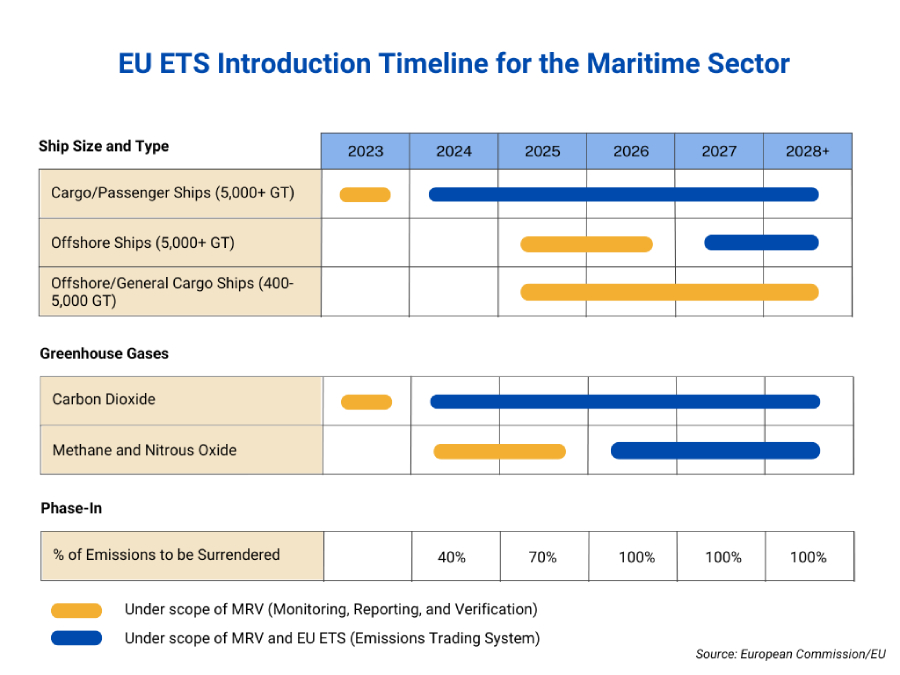Phase 1: 2024-2026 – Gradual Inclusion and Initial Reporting
During this initial phase, which began in January of 2024, cargo and passenger ships of or above 5000 GT must start reporting CO2, methane, and nitrous oxide emissions. Shipping companies should invest in efficient and accurate monitoring and reporting systems, ensuring compliance with the Monitoring, Reporting, and Verification (MRV) regulation. These requirements apply to 50 percent of emissions from voyages starting or ending outside of the EU and 100 percent of emissions that occur between two EU ports and when ships are within EU ports.
Phase 2: 2025-2027 – Increasing Allowance Requirements
In the next phase of the EU ETS expansion to the maritime sector, companies must start using allowances to cover 40% of their 2024 emissions by September 30, 2025, increasing to 70% for 2025 emissions and 100% from 2026 onwards. Companies must purchase emission allowances and incorporate the costs into their financial planning. This also encourages companies to explore strategies for reducing emissions, such as investing in cleaner technologies or optimizing routes and speeds.
The EU ETS being a cap and trade system means shipping companies will have a set limit on their emissions, known as a cap. They will need to buy allowances for each ton of CO2 they emit. If they emit less, they can sell excess allowances, but if they emit more, they must buy additional allowances. This incentivizes companies to reduce emissions to save costs or generate income from selling surplus allowances, which could fund investments in greener technologies and more efficient operations.
Phase 3: Post-2027 – Full Compliance and Potential Expansion
All ships covered by the EU ETS framework must be in full compliance by 2027, with possible expansions to include more types of vessels and additional greenhouse gasses. During this phase, shipping companies will need to submit allowances for 100 percent of their reported emissions. Shipping companies should begin to establish long-term emission reduction strategies, such as transitioning to renewable fuels and leveraging energy-efficient technologies.
Key Preparatory Steps for Shipping Companies
- Monitoring and Reporting: Implement a precise and reliable system for monitoring and reporting emissions, ensuring data accuracy and timely submission.
- Allowance Management: Develop a strategy for acquiring and managing allowances, including participating in the European Energy Exchange and secondary markets.
- Emission Reduction: Invest in sustainable practices and technologies to reduce overall emissions, such as upgrading to more efficient engines, improving operational efficiencies, and exploring alternative fuels.
- Regulatory Compliance: Stay informed about legislative updates and ensure all compliance measures are met, including the use of updated reporting templates and adherence to specific rules for ports of call and emissions at berth.
By preparing for each phase of the EU ETS, shipping companies can manage the incremental costs associated with the EU ETS framework more efficiently. This will not only help them comply with regulatory requirements, but also contribute to the global effort to mitigate climate change.
For more detailed information on EU ETS regulations, visit the European Commission’s pages on reducing emissions in the shipping sector and the EU ETS for maritime transport.
For information on how TS Cyanergy is helping shipping companies integrate more efficient, accurate, and cost effective emissions monitoring and reporting processes through our innovative software, subscribe to our newsletter or reach out today.

